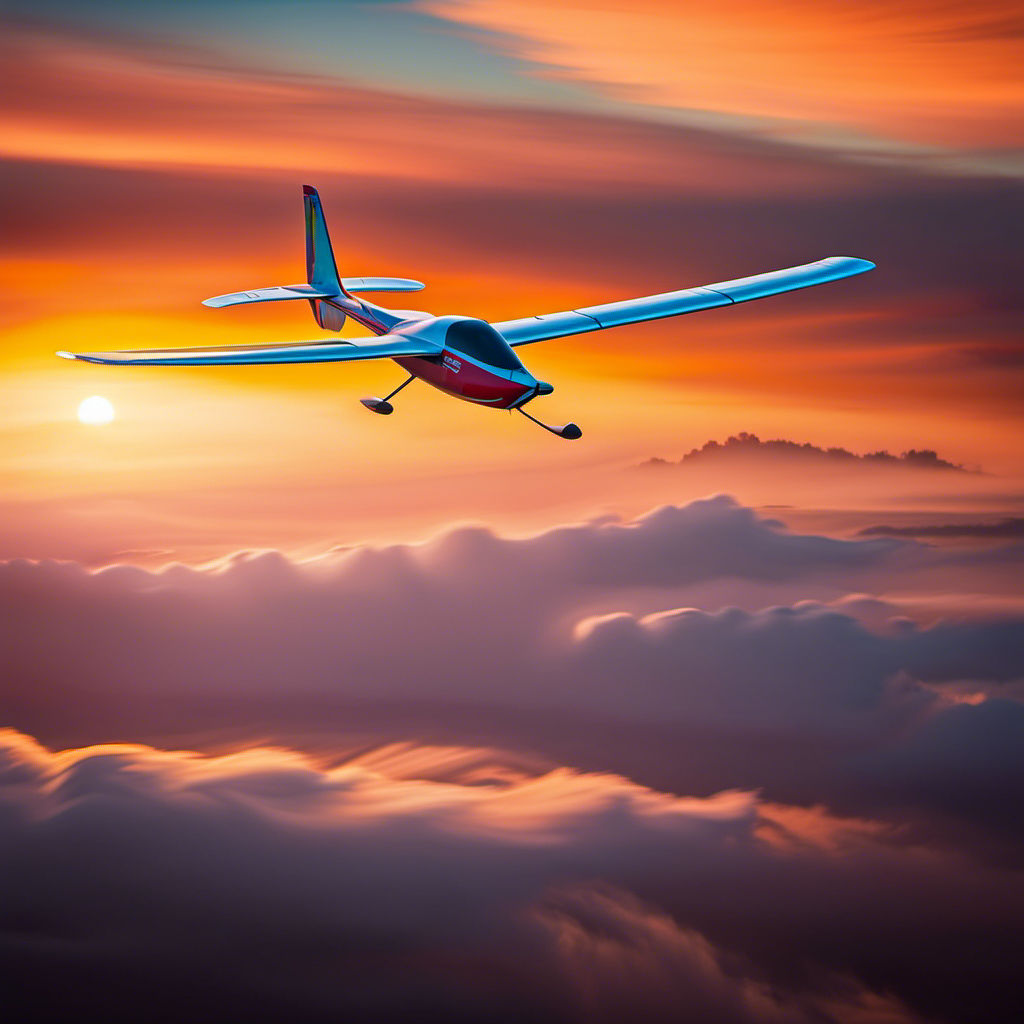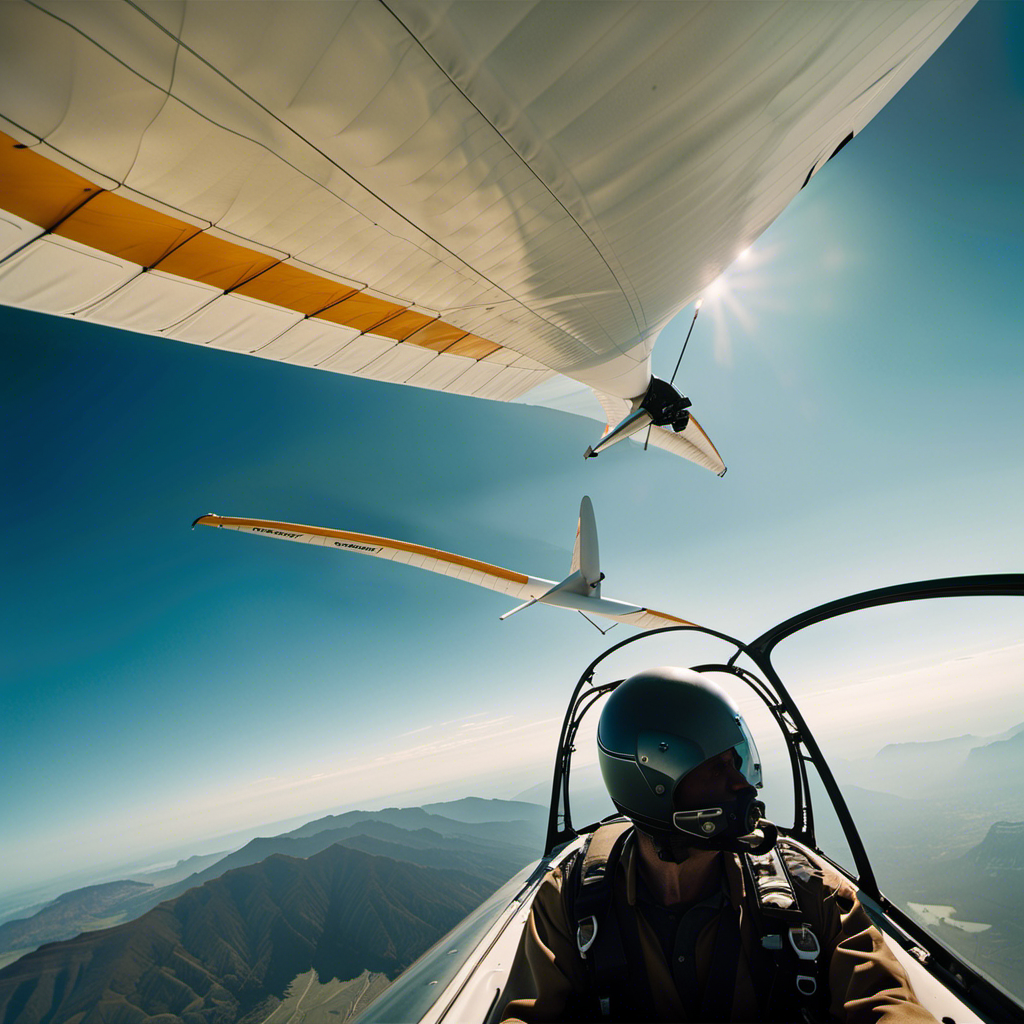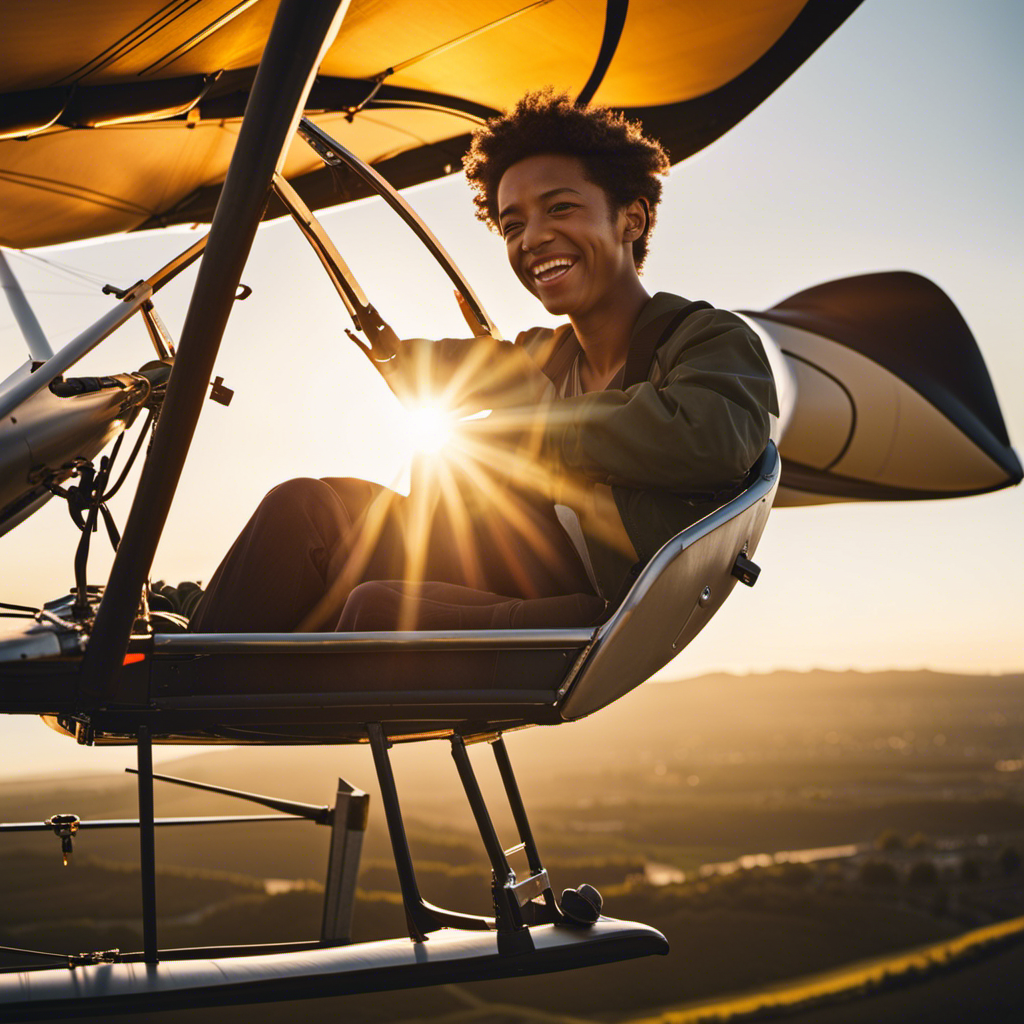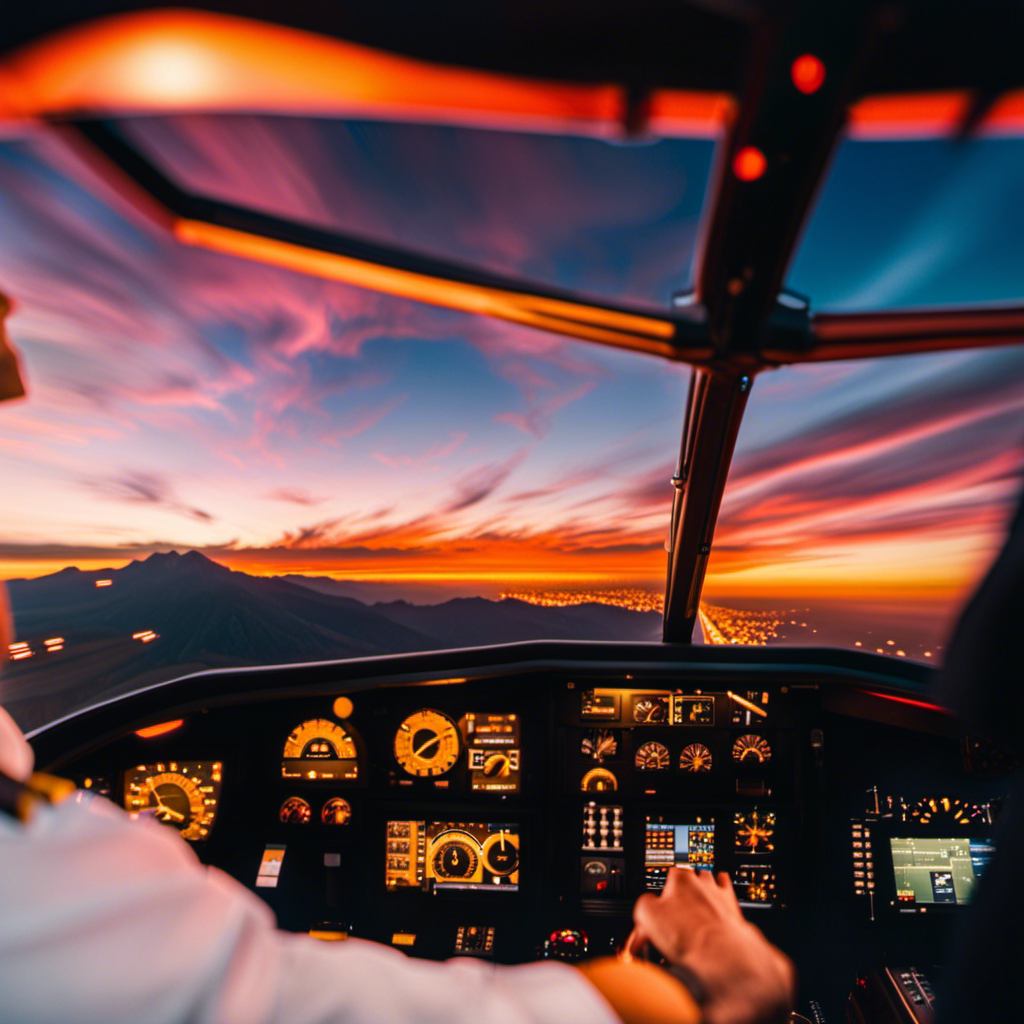If you have ever dreamt of soaring through the skies like a bird, then trying glider plane flying might just be the perfect adventure for you!
In this article, I’ll guide you through the ins and outs of obtaining a glider pilot license. From the basic requirements and training to the exciting world of solo flying, we’ll cover it all.
So strap in and get ready to embark on an exhilarating journey into the world of glider flying.
Key Takeaways
- There are different types of glider pilot licenses, including the Private Pilot License, Commercial Pilot License, and Flight Instructor License.
- Age and medical requirements must be met in order to obtain a glider pilot license.
- The glider pilot license application process involves various steps and requirements.
- A medical certificate is essential for glider flying as it ensures the pilot’s health and fitness for flying.
The Basics of Glider Flying
Learning the basics of glider flying is essential before obtaining a license. As a seasoned glider pilot, I can attest to the importance of mastering the fundamental techniques of this unique form of aviation. Glider flying requires a thorough understanding of aerodynamics and the ability to effectively control the aircraft without the aid of an engine.
One of the first things aspiring glider pilots must learn is how to properly launch and land the glider. Launching techniques can vary depending on the type of glider and the available resources at the airfield. Understanding the different launch methods, such as winch launching or aerotowing, is crucial to ensure a safe and successful takeoff. Similarly, mastering the art of landing is essential to prevent damage to the glider and ensure a smooth touchdown.
In addition to launch and landing techniques, understanding the weather conditions for glider flying is paramount. Gliders are highly susceptible to changes in wind patterns, thermal activity, and other atmospheric phenomena. Being able to read weather forecasts, interpret weather maps, and assess current conditions is crucial for planning safe and enjoyable flights. Moreover, developing the ability to recognize and exploit thermals, which are pockets of rising warm air, is essential for extended flights and gaining altitude.
With a solid foundation in glider flying techniques and weather knowledge, pilots can confidently progress towards obtaining their glider pilot licenses.
Types of Glider Pilot Licenses
There are different types of licenses for pilots who want to operate gliders. As a knowledgeable and experienced glider pilot, I can provide you with some insight into these licenses.
The first type of license is the Private Pilot License (PPL-G), which allows you to fly glider aircraft for recreational purposes. With this license, you can fly various types of glider aircraft, such as single-seat, two-seat, or even motorized gliders.
The next level is the Commercial Pilot License (CPL-G), which permits you to fly gliders for commercial purposes, such as offering glider rides or participating in flying competitions. This license requires more training and experience, as it involves more complex maneuvers and navigation skills.
Lastly, there is the Flight Instructor License (FI-G). With this license, you can train and certify new pilots to fly gliders. It’s a rewarding opportunity to share your knowledge and passion for glider flying.
Now, let’s discuss the age and medical requirements for obtaining these licenses.
Age and Medical Requirements
To obtain the different types of glider pilot licenses, you’ll need to meet specific age and medical requirements. These requirements ensure that you are physically and mentally fit to operate a glider aircraft safely.
Here are the key things you need to know about age and medical examinations for glider pilot licenses:
-
Age requirements: The minimum age to obtain a glider pilot license varies depending on the country or aviation authority. In some places, you can start training as young as 14 years old, while in others, you may need to be at least 16 or 17 years old. It’s important to check the specific age requirements in your jurisdiction.
-
Medical examinations: Before obtaining a glider pilot license, you’ll need to pass a medical examination conducted by an authorized aviation medical examiner. This examination ensures that you meet the physical and mental health standards necessary for safe glider flying. The examination typically includes an assessment of your vision, hearing, cardiovascular health, and general fitness.
-
Regular medical assessments: Once you hold a glider pilot license, you’ll be required to undergo periodic medical assessments to maintain your license. These assessments are designed to monitor your ongoing fitness to fly glider aircraft and ensure that you continue to meet the necessary medical standards.
Meeting the age and medical requirements is just the first step towards becoming a licensed glider pilot. The next section will delve into the training and education necessary to acquire the skills and knowledge needed for safe glider operation.
Training and Education
Once you’ve met the age and medical requirements, you’ll need to undergo training and education to acquire the necessary skills and knowledge for safe operation of a glider aircraft. Training for a glider pilot license is typically conducted at a flight school or a glider club. It is crucial to choose a reputable training facility with experienced instructors who hold appropriate flight instructor qualifications.
During the training, you will cover a wide range of topics, including aerodynamics, meteorology, navigation, aircraft systems, and emergency procedures. Classroom instruction will provide you with the theoretical foundation needed to understand the principles of flight and the operation of a glider. Additionally, you will have the opportunity to participate in practical flying exercises, where you will learn how to control the glider, perform takeoffs and landings, and handle various flight maneuvers.
The flight instructor qualifications of your trainers are essential as they ensure that you receive quality instruction and guidance throughout the training process. Experienced instructors will be able to tailor the training to your individual needs, ensuring that you progress at a pace suitable for you while also challenging you to improve your skills.
As you complete your training and gain proficiency in the necessary skills, you will transition into the subsequent section about flight hours and solo flying. This phase of your training will further enhance your abilities as a glider pilot and prepare you for the final step towards obtaining your glider pilot license.
Flight Hours and Solo Flying
During this phase of your training, you’ll log numerous flight hours and gain valuable experience by flying solo. It is an exciting and crucial step in becoming a licensed glider pilot. As you embark on this journey, it is essential to familiarize yourself with flight regulations and insurance requirements.
Flight regulations are put in place to ensure the safety of all pilots and passengers. These regulations outline the rules and guidelines that must be followed during flight operations. It is your responsibility to understand and adhere to these regulations to maintain a safe and secure flying environment.
In addition to flight regulations, insurance requirements are also crucial to consider. Glider pilots must have adequate insurance coverage to protect themselves and their aircraft from any potential mishaps. Insurance policies may vary, so it is important to carefully review and understand the specific coverage and limitations of your policy.
As you gain more flight hours and experience flying solo, you will develop a deeper understanding of the intricacies of glider flight. This knowledge will serve as a strong foundation as you move on to the next phase of your training, which involves honing your radio communication and navigation skills.
Transitioning into the realm of radio communication and navigation skills, you will learn how to effectively communicate with air traffic control and other pilots. These skills are essential for maintaining situational awareness and ensuring a safe and efficient flight.
Radio Communication and Navigation Skills
Learning how to effectively communicate and navigate using radio systems is a crucial skill for pilots. As a pilot, I’ve honed these skills through years of training and experience.
When it comes to radio communication, it’s essential to speak clearly and concisely, using standardized phraseology to ensure accurate transmission of information. This includes providing clear position reports, requesting necessary information from air traffic control, and acknowledging instructions promptly.
In terms of navigation skills, pilots rely on a variety of instruments and techniques to determine their position and navigate safely. These include using navigational aids such as VORs (Very High Frequency Omnidirectional Range), GPS (Global Positioning System), and charts to plan and follow routes. Pilots must also be proficient in interpreting and utilizing instrument approach procedures to safely land at their destination.
As I transition into discussing the glider pilot license application process, it’s important to note that radio communication and navigation skills are not only essential for powered aircraft but also for gliders. While gliders may not have engines, pilots still need to communicate with air traffic control and other aircraft to ensure safe flight operations. Furthermore, navigation is crucial for glider pilots as they rely on thermals and wind patterns to stay aloft and navigate to their desired landing areas.
Glider Pilot License Application Process
To apply for a glider pilot license, you’ll need to complete the necessary paperwork and pass a series of exams to demonstrate your knowledge and skills. The glider pilot license requirements vary depending on the country and aviation authority, but generally, you’ll need to be at least 16 years old and hold a valid medical certificate. The cost of obtaining a glider pilot license can also vary, but it typically includes fees for training, exams, and administrative expenses.
Here is a table highlighting some common glider pilot license requirements and estimated costs:
| Requirement | Description | Estimated Cost |
|---|---|---|
| Medical Certificate | A medical examination to ensure you meet the physical requirements. | $100 – $200 |
| Ground School | Classroom instruction covering topics such as aerodynamics and rules. | $500 – $1,000 |
| Flight Training | Practical flying lessons with an instructor to develop your skills. | $2,000 – $5,000 |
| Written Exam | A knowledge test to assess your understanding of glider operations. | $100 – $200 |
| Practical Exam | A flight test to demonstrate your flying abilities. | $300 – $500 |
Once you have obtained your glider pilot license, there are opportunities for continuing education and endorsements to expand your skills and fly different types of gliders. These additional qualifications can open up new possibilities and enhance your flying experience.
Continuing Education and Endorsements
After obtaining your glider pilot license, you can further expand your skills and broaden your opportunities through continuing education and endorsements.
Continuing education is crucial in the aviation industry as it allows you to stay updated with the latest techniques, regulations, and safety protocols. By participating in advanced training courses, you can enhance your knowledge and proficiency in various aspects of glider flying. These courses may cover topics such as meteorology, navigation, emergency procedures, and advanced flight maneuvers.
In addition to continuing education, obtaining pilot endorsements is another way to enhance your skills and open up new possibilities. Endorsements are additional qualifications that allow you to fly specific types of gliders or engage in specialized activities. For example, an endorsement might be required to fly high-performance gliders or to conduct aerobatic maneuvers. By obtaining these endorsements, you can expand your capabilities and explore different facets of glider flying.
By engaging in continuing education and obtaining pilot endorsements, you demonstrate your commitment to excellence and continuous improvement. These additional qualifications not only enhance your skills but also make you more attractive to potential employers or gliding clubs.
Joining gliding clubs and organizations provides a unique opportunity to connect with fellow enthusiasts, share experiences, and learn from one another. These clubs often offer mentorship programs, organized competitions, and access to specialized equipment. Becoming a part of these communities allows you to immerse yourself in the world of gliding and further develop your skills through practical experience and collaborative learning.
Joining Gliding Clubs and Organizations
Joining gliding clubs and organizations offers a unique opportunity to connect with fellow enthusiasts and immerse yourself in the world of gliding. As someone who has been a member of several clubs over the years, I can attest to the many benefits that come with joining these communities.
Here are some key reasons why joining gliding clubs is a great idea:
- Networking: By becoming a member, you gain access to a network of experienced glider pilots who can provide guidance, share tips, and offer support.
- Community: Gliding clubs foster a sense of camaraderie among members, creating a welcoming and inclusive atmosphere where you can make lifelong friends who share your passion for gliding.
- Resources: Clubs often have their own fleet of gliders, which means you can gain access to a variety of aircraft without the need for personal ownership. Additionally, clubs may offer training programs, workshops, and flying events to help improve your skills.
While some clubs may require joining fees, the benefits far outweigh the costs. Being part of a club also opens up opportunities to participate in gliding competitions, where you can showcase your skills and compete against other pilots.
Now, let’s shift our focus to the importance of safety and regulations in gliding.
Safety and Regulations
Safety and regulations are essential aspects of gliding that ensure the well-being of pilots and maintain a standard of operation. As a licensed glider pilot, I understand the importance of adhering to these guidelines to ensure a safe and enjoyable flying experience. To become a qualified glider pilot, one must meet certain pilot qualifications. These qualifications typically include a minimum age requirement, a certain number of flight hours, and successful completion of written and practical exams. Additionally, pilots must comply with airspace regulations to ensure the safety of themselves and other aircraft. These regulations dictate where gliders can fly, what altitudes they can reach, and how they must interact with other aircraft in shared airspace. To help you better understand the regulations and their significance, I have provided a table below:
| Regulation | Description |
|---|---|
| Minimum Age | Pilots must be at least 14 years old to fly solo in a glider. |
| Flight Hours | Pilots must complete a minimum of 40 flight hours, including a specified number of solo flights. |
| Written Exam | Pilots must pass a written exam covering topics such as aerodynamics, meteorology, and navigation. |
| Practical Exam | Pilots must demonstrate their flying skills and knowledge during a practical exam with a certified examiner. |
| Airspace Restrictions | Gliders must adhere to specific altitude restrictions and follow designated flight paths to avoid interfering with other aircraft. |
Frequently Asked Questions
What are the benefits of joining a gliding club or organization?
Joining a gliding club or organization offers numerous benefits. You become part of a supportive community, gain access to valuable resources, and receive training opportunities. It’s a fantastic way to immerse yourself in the world of gliding and enhance your skills.
Can I fly a glider plane if I have a medical condition?
Yes, it is possible to fly a glider plane safely even with certain medical conditions. However, it is important to consult with a qualified aviation medical examiner to ensure that your condition does not pose any risks during glider flying.
Can I fly a glider plane if I have a criminal record?
Having a criminal record can impose flying restrictions depending on the severity of the offense. It’s crucial to consult with aviation authorities to determine the impact on your ability to fly a glider plane.
How much does it cost to get a glider pilot license?
Getting a glider pilot license is a worthwhile investment. The cost of training varies depending on location and instructor fees, but can range from $2,000 to $10,000. The duration of training typically takes around 20 to 40 hours of flight time.
Are there any restrictions on flying a glider plane at night?
When it comes to night flying in a glider plane, there are certain restrictions in place for safety reasons. These restrictions include limitations on visibility, specific training requirements, and the use of proper lighting equipment.
Conclusion
In conclusion, obtaining a glider pilot license requires dedication, determination, and a love for the sky.
The journey to becoming a licensed glider pilot involves learning the basics of glider flying, meeting age and medical requirements, and completing extensive training and education.
With enough flight hours and solo flying experience, one can apply for a glider pilot license. However, the learning doesn’t stop there.
Continuous education and endorsements are essential to stay updated with safety regulations and advancements in glider flying.
Soar to new heights and join the exciting world of gliding today!
Orion, better known as “Jetstream,” is the voice that brings the stories of the skies to life. His fascination with aviation began at a young age, sparked by his father’s tales of flying and adventure. Orion’s journey into the world of gliding was serendipitous, and from the moment he took his first glider flight, he knew he had found his calling.










